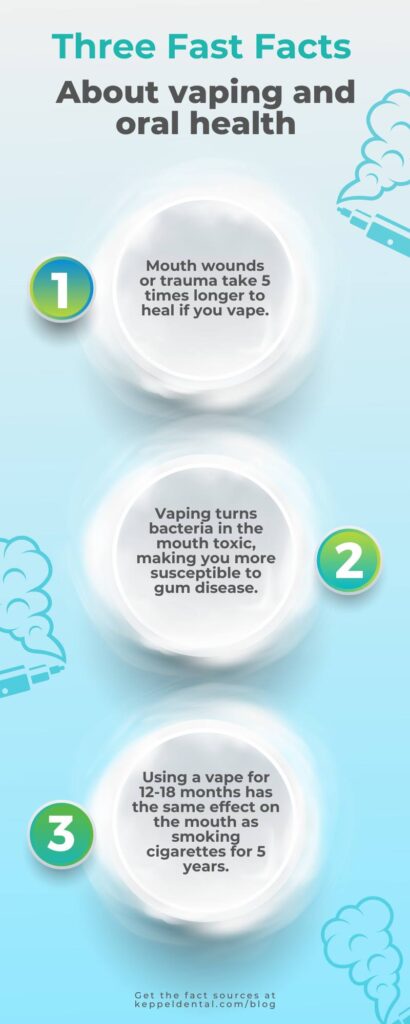The damage cigarettes have on the human body is well documented. Links between smoking and some pretty awful health consequences have been proven beyond doubt. But what we know about vaping is a lot less concrete, although that’s steadily changing.
E-cigarettes have been available to the mass market for more than 20 years. (The first mainstream vape was made in 2003.) But it’s taken this long to gather enough reliable data and complete enough studies for medical professionals to draw conclusions about how vaping affects oral health.
And the findings don’t look good. In fact, vaping may actually be worse for your teeth and gums than cigarettes.

The original vaping promises
Nicotine is addictive. But for many smokers the ritual and feeling of holding and having a cigarette is just as comforting.
When vapes first came out they were largely marketed as a better alternative to cigarettes, especially when filled with nicotine-free e-liquids. And they allowed smokers to enjoy the same action of putting something to their mouth, inhaling something similar to smoke, and breathing it out again. They were also promoted as a way to help people quit smoking, or at least cut down.
But the truth (and what sceptics were saying as early as 2008) is that we don’t know enough about the contents of e-liquids, and the long-term effects vaping may have on the body.
Finding something that could potentially mimic the act but be safer than smoking was an attractive option. And not just to those who already smoked and were looking to stop.
What actually happened
After a decade, media reports started emerging about people who never smoked taking up vaping.
It also became a growing habit among young people. In much the same way that cigarettes were touted as being ‘cool’ before their health effects became known, vaping was promoted as an attractive alternative.
Films and TV shows even started including scenes of people vaping, as it seemed more acceptable than smoking.
It was around this time that the mutterings from the medical industry became louder. No one really knew about the chemicals in e-cigs, and the effect of inhaling their vapour. But there was growing concern that e-cigs may not be useful when trying to quit and that they might not be any safer than smoking cigarettes.
How the products were marketed also started to change. Sweet-flavoured liquids and cheaply produced single-use vapes made them appealing and affordable to a younger audience. So vapes were being questioned not only in terms of health but also in terms of their environmental impact due to the amount of waste they produced.
Australian dentists call for changes to vaping laws
In May 2023, the Australian Dental Association (and therefore its members) announced it was backing the government’s proposed changes to the vaping laws, largely because one in four 18-to-24-year-olds were vaping.
But while the laws have only recently changed, the dental profession feels it’s been a long time coming.
For years dentists have been commenting on links between patients who vaped and their increased risk of gum disease, carries, and bleeding in the mouth. And we’re finally starting to get the data and research supporting their suspicions.
Reliable studies and data into vaping and oral health
The tobacco industry has been around since the 1700s. But it wasn’t until the 1920s that the first medical reports linking smoking to lung cancer started to emerge. And it was another 30 years before the damaging effects of smoking became widely recognised.
Advances in technology, and people’s general understanding of health and wellbeing, are much better than they were in the early twentieth century. So taking 20 years to gather reliable data about vaping, and for society to start acting on those recommendations, is actually pretty swift.
Here’s what we know so far from the research.

Vaping changes the bacteria in the mouth
The claim: Dr Purnima Kumar, a Professor of Dentistry and Principal Investigator of Oral Microbial Ecology Laboratory at the University of Michigan, spent years studying the effects of cigarettes on the mouth. But with the rise of vaping, she and her team turned their attention to this latest trend. Her first study into vaping questioned whether the chemicals in e-liquids and the act of vaping changed the bacteria in the mouth.
The study: She grew bacteria from her own mouth in a petri dish, and then exposed it to different vaping conditions to see what would happen.
The findings: Vaping turned the mouth bacteria toxic, creating a chemical slime and gunk on the teeth and gums that are hard to remove by daily brushing.
Source: Are e-cigarettes less dangerous to oral health than cigarettes?
Vaping plays a role in gum disease
The claim: New York University’s College of Dentistry set out to better understand how the chemicals in e-cigarettes changed the oral microbiome within the mouth, and how the change contributed to gum disease and receding gums.
The study: 84 adults were split into three groups: cigarette smokers, vape users, and people who had never smoked or vaped. The study looked at the presence of gum disease during 2 dental exams 6 months apart. Plaque was taken from the mouth of each person, and the bacteria was analysed.
The findings: At the start of the study, all participants had some level of gum disease. The smokers had the most severe disease, followed by the vapers. But at the 6-month exam, a key indicator of gum disease (clinical attachment loss) was significantly worse only in the vape users.
Clinical attachment loss is where gum ligament and tissue separate from the surface of a tooth. This causes the gum to recede and form pockets, which bacteria love to breed in. A buildup of this can lead to periodontal disease.
Source: Evidence grows for vaping’s role in gum disease
Vapers have a hard time healing
The claim: People who vape are slower to heal after a mouth injury, trauma or dental procedures.
The study: By making a small punch in the roof of the mouth, Dr Kumar and her team compared how well a group of non-vapers healed to people who vaped.
The findings: The mouths of those who didn’t vape healed in around 4 days. And after 7 days there was no sign of the wound at all. But the wounds in the mouths of those who vaped still hadn’t fully healed after 21 days.
This study also revealed the vapers had only been using the devices for 12-18 months, and yet showed the same healing patterns as someone who had smoked for at least 5 years. The conclusion: vaping is worse than smoking, damaging the mouth at a quicker rate than cigarettes.
Sources: Are e-cigarettes less dangerous to oral health than cigarettes?
Vaping damages teeth faster than smoking
Long-term health effects are still unknown
The suspicions and anecdotal evidence from dentists about the oral health condition in patients who vape are being confirmed. But links to mouth cancers and other more severe oral diseases are yet to be proven.
Dr Crystal Stinson, assistant professor at Texas A&M College of Dentistry in Dallas, commented in a vaping and oral health article that “Not enough time has passed since vaping became popular to assess the long-term dangers. Unfortunately, everybody’s an experiment right now.”
Sorting myth from reality
As part of their anti-vaping drive, NSW Health collated all the evidence used in their messaging—from stats on the number of young people vaping to the effects of inhaling chemicals as vapour. And they used it to put together an extensive list that leaves little debate around whether vaping causes damage.
Read the vaping evidence summary.
Ready to improve how healthy your mouth is? Start by adding the best foods for healthy teeth and gums to your diet.
